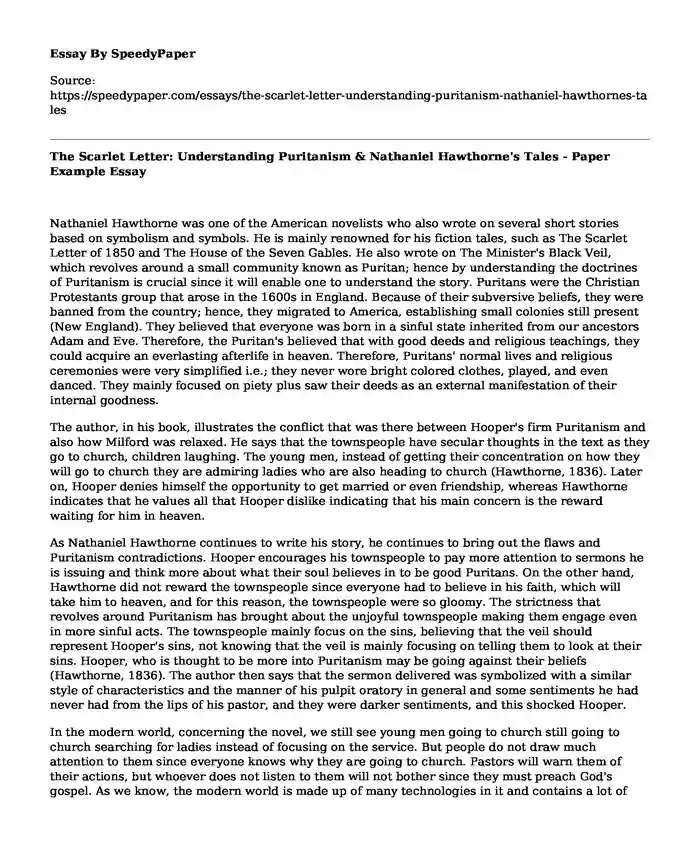
| Type of paper: | Essay |
| Categories: | American literature |
| Pages: | 3 |
| Wordcount: | 610 words |
Nathaniel Hawthorne was one of the American novelists who also wrote on several short stories based on symbolism and symbols. He is mainly renowned for his fiction tales, such as The Scarlet Letter of 1850 and The House of the Seven Gables. He also wrote on The Minister's Black Veil, which revolves around a small community known as Puritan; hence by understanding the doctrines of Puritanism is crucial since it will enable one to understand the story. Puritans were the Christian Protestants group that arose in the 1600s in England. Because of their subversive beliefs, they were banned from the country; hence, they migrated to America, establishing small colonies still present (New England). They believed that everyone was born in a sinful state inherited from our ancestors Adam and Eve. Therefore, the Puritan's believed that with good deeds and religious teachings, they could acquire an everlasting afterlife in heaven. Therefore, Puritans' normal lives and religious ceremonies were very simplified i.e.; they never wore bright colored clothes, played, and even danced. They mainly focused on piety plus saw their deeds as an external manifestation of their internal goodness.
The author, in his book, illustrates the conflict that was there between Hooper's firm Puritanism and also how Milford was relaxed. He says that the townspeople have secular thoughts in the text as they go to church, children laughing. The young men, instead of getting their concentration on how they will go to church they are admiring ladies who are also heading to church (Hawthorne, 1836). Later on, Hooper denies himself the opportunity to get married or even friendship, whereas Hawthorne indicates that he values all that Hooper dislike indicating that his main concern is the reward waiting for him in heaven.
As Nathaniel Hawthorne continues to write his story, he continues to bring out the flaws and Puritanism contradictions. Hooper encourages his townspeople to pay more attention to sermons he is issuing and think more about what their soul believes in to be good Puritans. On the other hand, Hawthorne did not reward the townspeople since everyone had to believe in his faith, which will take him to heaven, and for this reason, the townspeople were so gloomy. The strictness that revolves around Puritanism has brought about the unjoyful townspeople making them engage even in more sinful acts. The townspeople mainly focus on the sins, believing that the veil should represent Hooper's sins, not knowing that the veil is mainly focusing on telling them to look at their sins. Hooper, who is thought to be more into Puritanism may be going against their beliefs (Hawthorne, 1836). The author then says that the sermon delivered was symbolized with a similar style of characteristics and the manner of his pulpit oratory in general and some sentiments he had never had from the lips of his pastor, and they were darker sentiments, and this shocked Hooper.
In the modern world, concerning the novel, we still see young men going to church still going to church searching for ladies instead of focusing on the service. But people do not draw much attention to them since everyone knows why they are going to church. Pastors will warn them of their actions, but whoever does not listen to them will not bother since they must preach God's gospel. As we know, the modern world is made up of many technologies in it and contains a lot of unfaithful acts that are against what God expects of us. Therefore, Nathaniel’s book majorly describes the good deeds that as the children of God should engage in.
Work Cited
Hawthorne, N., 1836. The Minister’s Black Veil.
Cite this page
The Scarlet Letter: Understanding Puritanism & Nathaniel Hawthorne's Tales - Paper Example. (2023, Nov 25). Retrieved from https://speedypaper.com/essays/the-scarlet-letter-understanding-puritanism-nathaniel-hawthornes-tales
Request Removal
If you are the original author of this essay and no longer wish to have it published on the SpeedyPaper website, please click below to request its removal:
- Literary Essay Sample on Arthur Koestler's Darkness at Noon
- Book Review Essay Sample: Sam Patch, The Famous Jumper by Paul E. Johnson
- Feminism Theory in Analysis of Poems
- Free Essay Example on The Tempest by William Shakespeare
- Free Essay on Screening for Thyroid Disease
- Rifa'a Tahtawi: Free Paper
- Paper Example on Galactic Heroism: Analyzing Acts of Bravery in Star Wars (1977)
Popular categories




